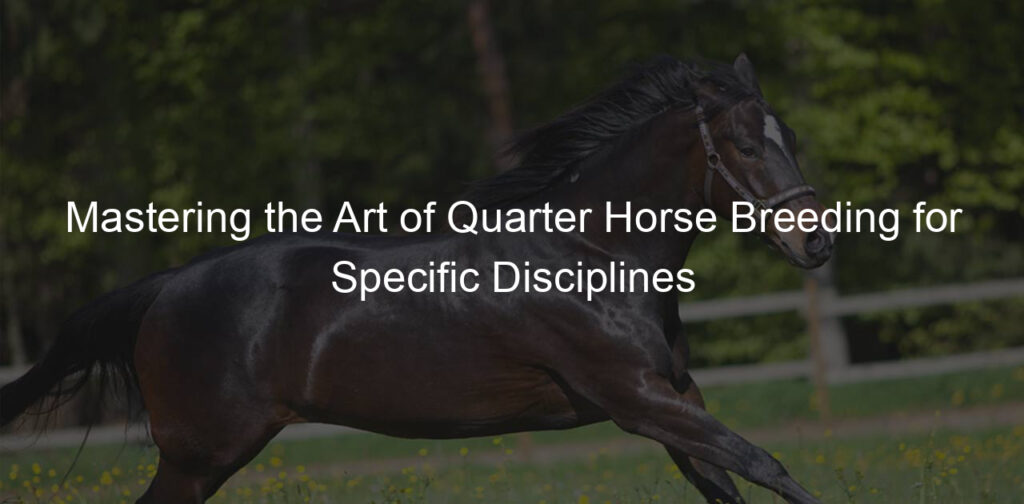Introduction to Quarter Horse Breeding
Hey there, horse lovers! Today, we’re going to dive into the fascinating world of Quarter Horse breeding. So, saddle up and let’s get started!
- Overview of the Quarter Horse breed
- Importance of selective horse breeding
- Role of Quarter Horse genetics in breeding
Known for their speed and agility, the Quarter Horse is one of the oldest and most popular horse breeds in America. They’re named ‘Quarter Horse’ because they can outdistance other horse breeds in races of a quarter mile or less. They’re not just fast, but also incredibly versatile, making them perfect for a variety of activities like racing, rodeo events, and even as work horses on ranches.
Selective breeding is like being a matchmaker for horses. It’s all about choosing the right parents to produce the best foals. By carefully selecting which horses to breed, we can enhance certain traits, like speed, strength, or temperament. This is super important in maintaining the quality and characteristics that make the Quarter Horse breed so special.
Genetics play a huge role in horse breeding. It’s like a secret code that determines everything about a horse, from its color to how fast it can run. In Quarter Horse breeding, understanding genetics can help breeders produce horses with desired traits. For instance, if a breeder wants a fast, agile horse, they might choose parents with a history of those traits. It’s a bit like a horse version of a family tree!
So, that’s a quick gallop through the basics of Quarter Horse breeding. Stick around as we delve deeper into the world of horse genetics, breeding techniques, and more in the upcoming sections. Happy horsing around!
Understanding Quarter Horse Genetics
Hey there, horse lovers! Today, we’re going to dive into the fascinating world of Quarter Horse genetics. Don’t worry, we’ll keep it simple and fun!
Basics of Equine Genetics
Before we get into the specifics of Quarter Horse genetics, let’s start with some basic stuff about horse genetics in general.
- Introduction to Equine Genetics
- How Genetics Influence Horse Characteristics
- Importance of Genetics in Horse Breeding
So, what exactly is equine genetics? Well, it’s the study of how traits in horses are passed from parents to their offspring. It’s like a horse’s blueprint! Each horse has a unique set of genes that determine everything from its color to its speed. Cool, right? You can learn more about it on Wikipedia.
Ever wondered why some horses are fast runners while others are great jumpers? Or why some horses are chestnut and others are black? That’s all down to genetics! For example, the gene for speed in horses is dominant. That means if a horse has just one copy of this gene, it’s likely to be a fast runner. Amazing, isn’t it?
Understanding genetics is super important for horse breeding. Breeders can use genetic information to predict the traits of potential offspring. This helps them to breed horses with desired characteristics, like speed, strength, or a certain color. It’s like being a horse matchmaker!
So, that’s the basics of equine genetics. But remember, each breed of horse has its own unique set of genes. And that’s where the Quarter Horse comes in!
Specifics of Quarter Horse Genetics
-
Unique genetic traits of the Quarter Horse breed
The Quarter Horse breed is known for its unique genetic traits. These horses are famous for their muscular build, compact body, and exceptional speed over short distances. This is primarily due to a specific gene called the “Speed Gene“, which is predominantly found in Quarter Horses. This gene is responsible for their fast-twitch muscle fibers, allowing them to sprint quickly.
-
How genetics influence Quarter Horse breed characteristics
Genetics play a significant role in shaping the characteristics of the Quarter Horse breed. For instance, the color of a Quarter Horse’s coat is determined by a combination of multiple genes. The most common colors are sorrel (a type of chestnut), black, bay, and brown. However, you can also find Quarter Horses in less common colors like palomino, buckskin, and gray, thanks to the genetic diversity within the breed.
Another key characteristic influenced by genetics is the horse’s temperament. Quarter Horses are known for their calm and steady demeanor, which is a trait passed down through generations. This makes them ideal for various activities, from racing and rodeo events to leisure riding and therapeutic riding programs.
-
Role of genetics in breeding Quarter Horses
Genetics play a crucial role in breeding Quarter Horses. Breeders often select horses for breeding based on their genetic traits to produce offspring with desired characteristics. For example, if a breeder wants to produce a fast racing Quarter Horse, they might choose parents who both carry the Speed Gene.
It’s also important to note that while genetics can predict certain traits, they don’t guarantee them. Other factors like environment, training, and care can also influence a horse’s characteristics. Therefore, successful breeding involves a combination of understanding genetics and providing a nurturing environment.
Horse Breeding Techniques
Let’s dive into the fascinating world of horse breeding techniques. We’ll start with the traditional methods that have been used for centuries.
Traditional Horse Breeding Techniques
Traditional horse breeding techniques have been passed down through generations. They are time-tested methods that have produced some of the finest horses in history.
- Overview of traditional breeding techniques
- Pros and cons of traditional breeding techniques
- Case study: Traditional breeding techniques in practice
Traditional horse breeding techniques rely on natural processes. This includes allowing the mare and stallion to mate naturally. The mare’s heat cycle is closely monitored, and the mating is timed to increase the chances of conception. This method requires a deep understanding of horse behavior and biology.
One of the main advantages of traditional breeding techniques is that they are natural and less invasive for the horses. They also allow for the selection of traits based on the physical characteristics and performance of the parents.
However, these techniques also have some drawbacks. They require a lot of time, patience, and expertise. There is also a risk of injury to the horses during mating. Plus, the success rate can be lower compared to modern techniques.
Let’s look at an example of traditional breeding techniques in action. The American Quarter Horse is a breed that has been developed largely through traditional breeding methods. Breeders have selected horses with speed, agility, and a calm temperament to create this versatile breed.
One famous Quarter Horse breeder, Bob Baffert, has used traditional breeding techniques to produce some of the top racing Quarter Horses in the country. His success shows that these techniques can still produce excellent results.
Stay tuned for our next section where we will explore modern horse breeding techniques and how they are revolutionizing the world of horse breeding!
Modern Horse Breeding Techniques
Hey there, horse lovers! Today, we’re going to dive into the exciting world of modern horse breeding techniques. These methods are all about using science and technology to make horse breeding more efficient and successful. So, let’s get started!
- Introduction to modern breeding techniques
- Advantages of modern breeding techniques
- Example: Modern breeding techniques in Quarter Horse breeding programs
Modern horse breeding techniques have come a long way from the traditional methods. They involve the use of advanced technologies like artificial insemination, embryo transfer, and even genetic testing. These techniques allow breeders to select the best traits in horses and ensure they are passed on to the next generation. Cool, right?
So, why are these modern techniques so great? Well, there are a few reasons. First, they allow breeders to produce more foals from a single mare in a year. That’s a big deal! Second, they can help to prevent the spread of diseases that can occur with natural breeding. And third, they allow for the preservation of valuable genetics from horses that may not be able to breed naturally. That’s a win-win-win in our book!
Now, let’s talk about how these techniques are used in Quarter Horse breeding programs. For instance, artificial insemination is commonly used. It allows breeders to use semen from top-quality stallions that may be located far away. This means they can improve the quality of their herd without the need for long-distance travel. Plus, embryo transfer allows a mare to have multiple foals in a year, which can be a big boost to a breeding program.
So, there you have it, folks! Modern horse breeding techniques are a game-changer in the world of horse breeding. They offer numerous advantages and have been successfully used in Quarter Horse breeding programs. So, next time you see a beautiful Quarter Horse, remember, it’s not just nature, but also science and technology at work!
Specific Disciplines in Horse Breeding
Hey there, horse lovers! Today, we’re going to dive into a super cool topic: discipline-specific horse breeding. It’s like creating a custom-made Quarter Horse, perfect for a specific job. Let’s get started!
Discipline-Specific Horse Breeding
So, what exactly is discipline-specific horse breeding? Well, it’s all about creating a horse that’s perfect for a specific job or discipline. It’s like making a superhero horse, with special powers for their specific task!
- Understanding discipline-specific horse breeding
- Role of discipline-specific breeding in creating specialized Quarter Horses
- Case study: Successful discipline-specific horse breeding programs
Discipline-specific horse breeding is all about matching the right parents to create a foal with the perfect skills and traits. For example, if you want a Quarter Horse that’s great at barrel racing, you’d choose parents who are fast and agile.
Discipline-specific breeding is super important in creating specialized Quarter Horses. It’s like a recipe: you need the right ingredients to make the perfect cake. In this case, the ingredients are the parents’ traits, and the cake is a super talented Quarter Horse!
Let’s look at a real-life example. The American Quarter Horse Association has a successful breeding program that’s produced many champion Quarter Horses. They carefully select the parents, considering their skills, health, and temperament. And the result? Superstar horses that excel in their disciplines!
So, that’s a quick look at discipline-specific horse breeding. It’s a fascinating process, and it’s amazing to see how it can create such talented Quarter Horses. Stay tuned for more horse breeding insights!
Breeding for Specific Quarter Horse Disciplines
When it comes to breeding Quarter Horses, it’s not a one-size-fits-all approach. Different disciplines require different traits, and as a breeder, it’s your job to ensure that your horses have the right characteristics to excel in their chosen field. Let’s dive into how you can breed Quarter Horses for specific disciplines, the key considerations you need to keep in mind, and some examples of successful breeding programs.
- How to breed Quarter Horses for specific disciplines
- Key considerations in discipline-specific Quarter Horse breeding
- Example: Breeding Quarter Horses for cutting, reining, and barrel racing
Each discipline requires a different set of skills and traits. For example, a cutting horse needs quick reflexes and a strong sense of cattle, while a reining horse requires precise control and agility. As a breeder, you need to understand these requirements and select parent horses that exhibit these traits. It’s also important to consider the horse’s lineage, as certain bloodlines are known for excelling in specific disciplines.
When breeding for a specific discipline, there are a few key considerations to keep in mind. First, you need to understand the physical and mental requirements of the discipline. Second, you need to select parent horses that not only excel in the discipline but also have a history of producing successful offspring. Lastly, you need to consider the market demand for horses in that discipline. Breeding a top-notch cutting horse won’t do you much good if there’s no demand for cutting horses in your area.
Let’s take a look at how these considerations play out in real life. For cutting, you might select a sire and dam that have both excelled in cutting competitions and have a lineage of successful cutting horses. For reining, you might look for horses with a history of precise control and agility. And for barrel racing, you might look for horses with a combination of speed, agility, and a strong sense of direction.
Remember, breeding for a specific discipline is more than just selecting the right parents. It’s about understanding the discipline, the market, and the lineage of your horses. With careful planning and a bit of luck, you can breed Quarter Horses that excel in their chosen disciplines.
Understanding Quarter Horse Bloodlines
When it comes to Quarter Horse breeding, understanding the bloodlines is as important as understanding the genetics. Let’s dive into the fascinating world of Quarter Horse bloodlines and see why they’re so important.
- Importance of Quarter Horse bloodlines in breeding
- How to trace and evaluate Quarter Horse bloodlines
- Case study: Famous Quarter Horse bloodlines and their impact on the breed
Just like in humans, a horse’s bloodline can tell a lot about its potential abilities, health, and personality. In Quarter Horse breeding, bloodlines are crucial because they can predict the horse’s performance in various disciplines. For instance, some bloodlines are known for their speed, while others are famous for their agility or endurance. By choosing a horse from a specific bloodline, breeders can increase the chances of getting a foal with the desired traits.
Tracing a Quarter Horse’s bloodline might seem like a daunting task, but it’s actually quite straightforward. The American Quarter Horse Association (AQHA) maintains a comprehensive database of registered Quarter Horses, which can be used to trace a horse’s lineage. To evaluate a bloodline, you should look at the performance of the horse’s ancestors in the desired discipline. For example, if you’re interested in racing, you might want to choose a horse from a bloodline known for its speed.
Let’s take a look at one of the most famous Quarter Horse bloodlines – the King Ranch bloodline. This bloodline, which originates from the King Ranch in Texas, has produced many champion Quarter Horses over the years. Horses from this bloodline are known for their versatility, being able to excel in a variety of disciplines from racing to working cattle. The success of the King Ranch bloodline has had a significant impact on the breed, influencing many breeders to incorporate these genetics into their own breeding programs.
Understanding Quarter Horse bloodlines is a fascinating journey into the history and future of this versatile breed. By choosing a horse from a reputable bloodline, you can increase your chances of breeding a successful Quarter Horse.
Conclusion: Mastering the Art of Quarter Horse Breeding
As we gallop towards the end of this informative journey, let’s take a moment to reflect on the key points we’ve learned about Quarter Horse breeding. We’ve covered a lot of ground, from understanding the genetics to the specific disciplines in breeding. So, let’s rein in and summarize.
- Key takeaways on Quarter Horse breeding for specific disciplines: Breeding Quarter Horses isn’t just about genetics, it’s also about discipline. Whether you’re breeding for racing, showing, or work, it’s important to select a sire and dam that excel in the desired discipline. For example, a racing Quarter Horse should have a compact body and strong hindquarters, while a show horse should have a calm temperament and good conformation. Remember, a horse’s discipline can greatly influence its value and success in the breeding industry.
- Future trends in Quarter Horse breeding: The world of Quarter Horse breeding is always evolving. One trend we’re seeing is a move towards more sustainable breeding practices, with breeders focusing on quality rather than quantity. There’s also a growing interest in preserving the original Quarter Horse bloodlines, known for their versatility and hardiness. So, keep an eye out for these trends as they could shape the future of Quarter Horse breeding.
- Final thoughts on mastering the art of Quarter Horse breeding: Breeding Quarter Horses is both a science and an art. It requires a deep understanding of genetics, a keen eye for selecting the right horses, and a lot of patience. But the rewards can be immense, from the thrill of seeing a foal take its first steps, to the pride of watching a horse you bred win a race or a show. So, keep learning, keep experimenting, and most importantly, keep loving these incredible animals. As the famous horse breeder, Federico Tesio once said, “The Thoroughbred exists because its selection has depended, not on experts, technicians, or zoologists, but on a piece of wood: the winning post of the Epsom Derby. If you base your criteria on anything else, you will get something else, not the Thoroughbred.”
And that’s a wrap, folks! We hope you’ve enjoyed this trot through the world of Quarter Horse breeding. Remember, every horse is unique, and breeding is a journey, not a destination. So, saddle up and enjoy the ride!









